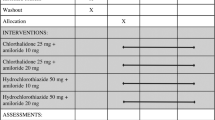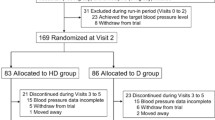Summary
The antihypertensive effect of moxonidine·HCl·H2O (MOX) was compared with that of clonidine·HCl (CLON) in a randomized double-blind crossover study in 20 hypertensive outpatients (BP range 154–178/96–108 mmHg). After 2 weeks without antihypertensive medication, either MOX 0.2 mg daily or CLON 0.2 mg daily was given and the dose was titrated until the diastolic blood pressure fell below 90 mmHg. The first treatment period was continued for 2 weeks and, after crossover without a wash-out period, it was followed by the second treatment for a further 2 weeks. Within the first 4 days of administration 0.2–0.4 mg of either agent caused a significant decrease in BP (p<0.001) from a mean of 166/100 mmHg to 149/86 mmHg after CLON (approx. −10/−14%), and 163/99 mmHg to 146/84 mmHg after MOX (approx. −10/−15%). No significant difference in the fall in BP or pulse rate was detected between the two drugs. In the mean daily dose of 0.3 mg both drugs showed the same antihypertensive activity, but on CLON a higher incidence of side effects (p=0.003) was noted, and after discontinuation of therapy a more rapid rise in BP (systolic BP p<0.01, diastolic BP p<0.02) was found. 17 patients on CLON complained of side effects, especially tiredness and dry mouth, whilst only 6 patients on MOX were affected (p=0.003).
Similar content being viewed by others
References
Armah B, Stenzel W (1981) BE-5895, a new clonidine-type antihypertensive aminopyrimidine derivative. Naunyn Schmiedebergs Arch Pharmacol 316 [Suppl]: R 42
Bock KD, Heimsoth V, Merguet P, Schönermark J (1966) Klinische und klinisch-experimentelle Untersuchungen mit einer neuen blutdrucksenkenden Substanz: Dichlorophenylaminoimidazolin. Dtsch Med Wochenschr 91: 1761–1770
Chrysant SG, Dillard BL, Smith WJ, Manion CV (1981) Antihypertensive effectiveness of clonidine and chlorthalidone as step 1 drugs. Curr Ther Res 30 (6): 943–955
Davidov M, Kakaviatos N, Finnerty FA (1967) The antihypertensive effects of an imidazoline compound. Clin Pharmacol Ther 8: 810–816
Davies DS, Wing LMH, Reid JL, Neill E, Tippett P, Dollery CT (1977) Pharmacokinetics and concentration-effect relationships of intravenous and oral clonidine. Clin Pharmacol Ther 21: 593–601
Garrett BN, Kaplan NM (1980) Clonidine in the Treatment of Hypertension. J Cardiovasc Pharmacol 2 [Suppl 1]: 561–571
Grabner G, Michalek P, Pokorny D, Vormittag E (1966) Klinische und experimentelle Untersuchungen mit der neuen blutdrucksenkenden Substanz 2-(2, 6-dichlorophenylamino)-2-imidazolin-hydrochlorid. Arzneimittelforsch 16: 1174–1177
Guthrie GP, Kotchen TA (1983) Effects of prazosin and clonidine on sympathetic and baroreflex function in patients with essential hypertension. J Clin Pharmacol 23: 348–354
Hansson L, Hunyor SN, Julius S, Hoobler SW (1973) Blood pressure crisis following withdrawal of clonidine (Catapres, Catapresan) with special reference to arterial and urinary catecholamine levels and suggestions for acute management. Am Heart J 85: 605–610
Hoefke W (1980) Pharmacology of antihypertensive drugs. Scriabine A (ed). Raven Press, New York, p 55
Holzgreve H (1980) Die Kooperation des Patienten bei der Hochdrucktherapie. Münch Med Wochenschr 122 [8]: 267–270
Hökfelt B, Hedeland H, Dymling JF (1970) Studies on catecholamines, renin and aldosterone following Catapresan®(2-(2,6-dichlorophenylamine)-2-imidazoline hydrochloride) in hypertensive patients. Eur J Pharmacol 10: 389–397
Kobinger W (1978) Central α-adrenergic systems as targets for hypotensive drugs. Rev Physiol Biochem Pharmacol 81: 40–100
Ng J, McGregor DD, Taylor KM, Smirk H (1967) Properties of Catapres, a new hypotensive drug: A preliminary report. N Z Med J 66: 864–870
Plänitz V, Hoffmann K (1983) First clinical data on moxonidine·HCl for treatment of mild to moderate hypertension. Naunyn-Schmiedebergs Arch Pharmacol 324 [Suppl]: R 79
Reid JL, Dargie HJ, Davies DS, Wing LMH, Hamilton CA, Dollery CT (1977) Clonidine withdrawal in hypertension. Lancet 1: 1171–1174
Reid JL, Rubin PC, Howden CW (1983) Central α2-adrenoceptors and blood pressure regulation in man: studies with guanfacine (BS 100–141) and azepexole (BHT 933). Br J Clin Pharmacol 15 [Suppl 4]: 463–469
Smet G, Hoobler SW, Sanbar S, Julius S (1969) Clinical observations on a new antihypertensive drug, 2-(2, 6-dichlorophenylamine)-2-imidazoline hydrochloride. Am Heart J 77: 473–478
Schmitt H (1977) The pharmacology of clonidine and related products. In: Gross F (ed) Antihypertensive drugs. Handbook of experimental pharmacology. Springer Berlin Heidelberg New York, Vol. 39: 299–396
Thananopavarn C, Golub MS, Eggena P, Barrett JD, Sambhi MP (1982) Clonidine, a centrally acting sympathetic inhibitor, as monotherapy for mild to moderate hypertension. Am J Cardiol 49 [1]: 153–158
Weber MA (1980) Discontinuation syndrome following cessation of treatment with clonidine and other antihypertensive agents. J Cardiovasc Pharmacol 2 [Suppl 1]: S73-S89
Wilber JA (1980) Clonidine: an introduction. J Cardiovasc Pharmacol 2 [Suppl 1]: S1-S3
Wing LMH, Reid JL, Davies DS, Neill EAM, Tippett P, Dollery CT (1977) Pharmacokinetic and concentration-effect relationships of clonidine in essential hypertension. Eur J Clin Pharmacol 12: 463–469
Yeh BK, Nantel A, Goldberg LI (1971) Antihypertensive effect of clonidine. Arch Intern Med 127: 233–237
Author information
Authors and Affiliations
Rights and permissions
About this article
Cite this article
Plänitz, V. Crossover comparison of moxonidine and clonidine in mild to moderate hypertension. Eur J Clin Pharmacol 27, 147–152 (1984). https://doi.org/10.1007/BF00544037
Received:
Accepted:
Issue Date:
DOI: https://doi.org/10.1007/BF00544037




